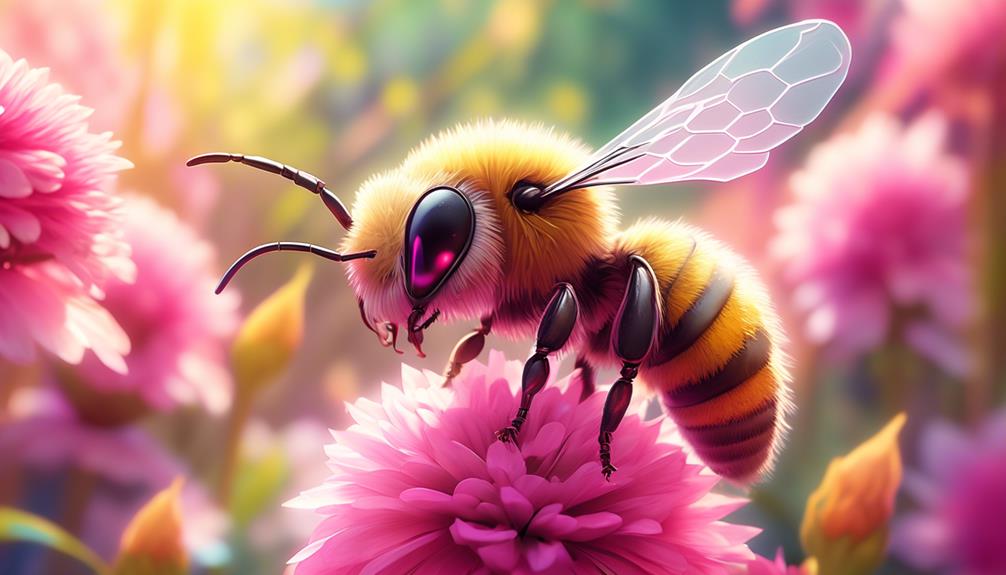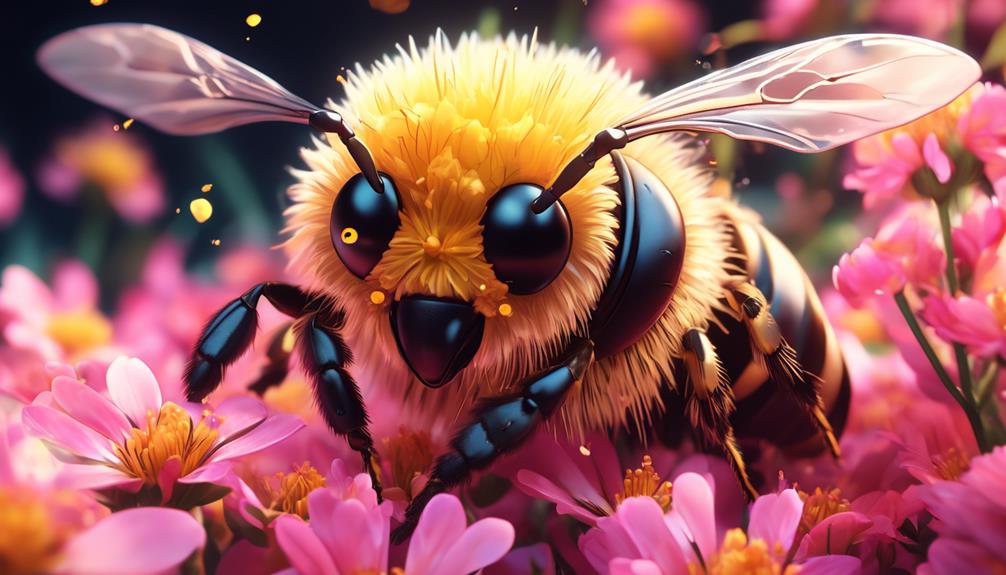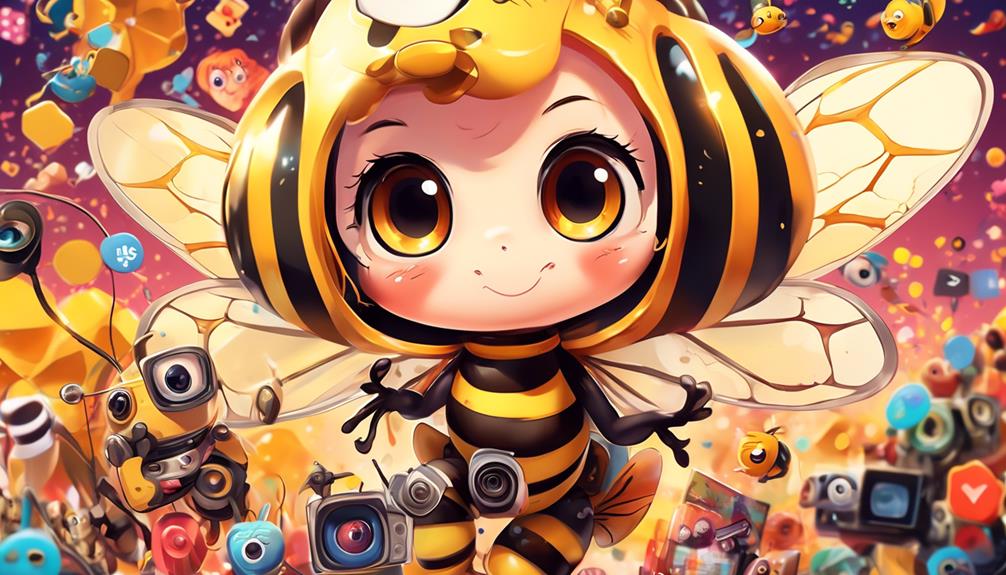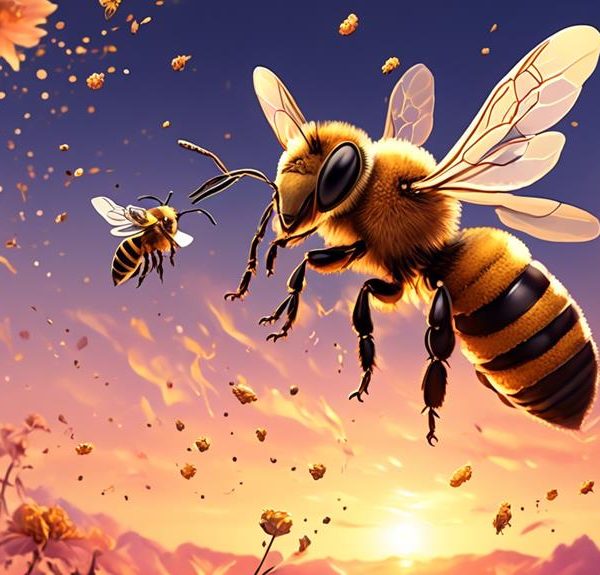Just when you thought bees were merely stinging insects, delve into their unexpected cuteness and why they captivate our hearts.

Why Are Bees so Cute?
While you're likely not considering adopting a bee as your next household pet, you've probably noticed a certain charm about these buzzing creatures, haven't you? You're wondering why bees, despite their stings, are so irresistible in their cuteness.
Is it their fluffy, round bodies, their tireless flight from flower to flower, or maybe the endearing representation in children's media that makes them so appealing?
As we explore this buzz-worthy topic further, you'll discover the intricate factors that contribute to their perceived cuteness, and why these tiny architects of nature hold a special place in our hearts.
Key Takeaways
- Bees possess physical characteristics that contribute to their cuteness, such as their fuzzy bodies, vibrant colors, and small size.
- Bees exhibit endearing behavior patterns, including their diligent work ethic, communication through the waggle dance, and defensive behaviors to protect the hive.
- Media perception plays a significant role in shaping our perception of bees, with positive portrayals enhancing their appeal and approachability.
- Humans have an innate attraction to nature, and bees' physical characteristics and behavior trigger a positive response, further enhancing their perceived cuteness.
The Unmistakable Physical Appeal

Diving into the physical appeal of bees, you'll quickly notice their three key features: the fuzzy body, vibrant colors, and small size, all contributing to their undeniable cuteness.
This fuzziness isn't just for show, though. It's actually a dense covering of hair that helps them collect pollen. As they buzz from flower to flower, pollen sticks to their bodies, aiding in the pollination process, a vital part of our ecosystem.
Their vibrant colors are another key feature. Bees range from a classic yellow and black to metallic green or even blue. These colors aren't random; they play a crucial role in their survival. Bright, contrasting colors can act as a warning to potential predators, signalling that the bee shouldn't be messed with.
Lastly, their small size adds to their appeal. Most bees are between 0.08 to 1.2 inches long, making them intriguing to observe but not intimidating. Their tiny bodies, coupled with their rapid wing movements, allow them to hover and zip around with ease.
This combination of fluffiness, vibrant colors, and small stature works together to create the bee's unique charm.
Understanding the "Cuteness Factor

So, what exactly is it that makes us perceive bees, and other small creatures, as 'cute'? Scientists refer to this as the 'cuteness factor', a subjective characteristic that triggers nurturing and protective instincts in many species, including humans.
This 'cuteness factor' is primarily influenced by what's known as 'Kindchenschema' or 'baby schema', a set of physical traits involving large eyes, chubby cheeks, and small noses. These traits are prevalent in infant humans, and also in bees, with their round bodies and large, expressive eyes.
Interestingly, research shows that our brains are hardwired to respond positively to these traits. A study from the University of Oxford found that viewing cute images activates the anterior cingulate cortex and the amygdala, areas of the brain associated with empathy and emotional connection.
Consequently, when you see a bee, your brain unconsciously tabs it as 'cute' because it mirrors these infantile traits, stimulating your nurturing instincts. This not only enhances your positive perception of bees but also prompts protective behavior, which is crucial for their conservation.
Understanding this 'cuteness factor' can help us harness the power of positive perception for conservation efforts.
Bees' Endearing Behavior Patterns

In addition to their physical traits, bees often captivate us with their unique and endearing behavior patterns. You've likely observed bees' diligent work ethic, tirelessly buzzing from flower to flower. This isn't mindless activity; it's a purposeful quest for nectar and pollen, critical for hive survival and reproduction. It's fascinating to witness their industrious, cooperative society, where each bee has a distinct role, from nurse bees that tend to larvae, foragers that gather food, to drone bees that mate with the queen.
You might've noticed their 'waggle dance,' a complex movement pattern used to communicate precise information about the location of a food source to other bees. Through variations in the dance's direction, duration, and intensity, bees convey distance and direction to nectar sources. It's an astonishing display of nature's ingenuity.
Moreover, bees exhibit defensive behavior patterns like swarming to protect their hive, demonstrating their strong communal bond. Bees aren't just cute; they're intriguing, their behaviors reflecting an advanced level of social organization and communication. It's these endearing behaviors, coupled with their physical traits, that make bees so captivating.
The Role of Media Perception

While bees' physical attributes and behavior patterns naturally endear them to us, it's also worth examining how media perception plays a significant role in shaping our view of these industrious creatures. You see, media representations significantly influence our perceptions, often subconsciously. This is particularly true for bees, which are frequently anthropomorphized in books, films, and advertisements.
Typically, bees are depicted as diligent, community-oriented, and friendly in media. This portrayal not only mirrors their real-life behaviors but enhances their appeal, making them seem more 'cute' and approachable. Characters such as Maya the Bee or Barry B. Benson from 'Bee Movie' illustrate this point brilliantly.
Furthermore, media often emphasizes the bees' pivotal role in pollination, indirectly portraying them as environmental heroes. This positive representation has an impact on public sentiment, fostering a greater appreciation for bees.
However, it's important to remember that media can also perpetuate misconceptions. For instance, bees are often confused with wasps, leading to an unwarranted fear. So, while media does play a part in the 'cuteness' factor of bees, it's essential to balance this perception with factual knowledge.
Our Innate Attraction to Nature

Equally significant in our perception of bees' cuteness is our inherent attraction to nature and all its diverse inhabitants. You see, this attraction is deeply rooted in our biology. Our ancestors relied heavily on nature for survival, hence we've evolved to have an innate appreciation for it.
At the heart of this lies the biophilia hypothesis, which postulates that humans have an instinctive bond with nature and other forms of life. This biological attraction extends to bees, the fuzzy, industrious pollinators that play a crucial role in our ecosystems.
Consider, for instance, the honeybee's golden hues and distinctive buzz. These characteristics not only catch our eye but also appeal to our auditory senses, triggering an instinctive positive response. You're subconsciously drawn to these traits, recognizing the bee's significance and beauty in nature.
Moreover, the complex social structures of bees, much like our own, fascinate us. Seeing a hive buzzing with activity, each bee performing its role diligently, you can't help but marvel at the harmony and efficiency, thus enhancing their perceived cuteness.
The Importance of Bees to Our Ecosystem

Beyond their adorable appearance, bees serve as nature's unsung heroes, playing a pivotal role in sustaining our ecosystems. You see, these tiny creatures are actually the world's most important pollinators of food crops. That's right, nearly a third of the food we consume each day relies directly on pollination, mainly by bees.
Through the process of pollination, bees transfer pollen from the male parts of a flower to the female parts. This allows plants to fruit and reproduce. Without bees, the availability of fruits, vegetables, and nuts would drastically decrease, upsetting the balance of our diets.
Moreover, bees enhance biodiversity. By pollinating flowers, they contribute to the creation of new plant populations, adding variety to our landscapes and habitats for other creatures. Furthermore, bees play an essential role in the food chain. They provide an important food source for birds and small mammals, indirectly supporting larger predators.
In essence, bees are the linchpins of our ecosystem. They maintain the balance of nature, and their decline could have potentially catastrophic effects. From the food we eat to the air we breathe, bees play a part in it all.
Frequently Asked Questions
Do All Species of Bees Appear Cute to Humans or Just Certain Ones?
It's subjective whether all species of bees appear cute to humans. Generally, our perception of cuteness is influenced by traits like size and fuzziness. Therefore, you might find smaller, fluffier bees like bumblebees cuter than others.
However, this could vary based on personal preferences and experiences. It's important to remember that all bees, regardless of their 'cuteness,' play a crucial role in our ecosystem.
How Does the Cuteness of Bees Impact Our Willingness to Protect Them?
Your perception of bees as cute can significantly influence your willingness to protect them. This emotional connection triggers empathy, encouraging protective behaviors.
When you find something cute, you're more inclined to care about its wellbeing. Hence, you're likely to support conservation efforts and adopt sustainable practices that protect bees' habitats.
This emotional response to their cuteness is a powerful tool in promoting environmental conservation and biodiversity.
Are There Any Cultural Differences in How the Cuteness of Bees Is Perceived?
Yes, cultural differences can affect how we perceive the cuteness of bees.
In some cultures, bees are seen as symbols of hard work and community, which can add to their cuteness.
Other cultures, however, may associate bees with fear due to their stinging capabilities. This fear may overshadow any perceived cuteness.
It's also worth noting that exposure to bees and education about their importance can influence these perceptions.
Are There Any Scientific Studies About the Psychological Effects of Finding Bees Cute?
You're asking if there's scientific research on the psychological impacts of finding bees cute. Unfortunately, there's no specific study addressing this.
However, general research suggests that humans are often drawn to small, harmless creatures, which could include bees. This is possibly due to their perceived vulnerability, triggering our instinct to nurture.
But remember, every individual's perception of 'cute' varies, influenced by personal experiences and cultural backgrounds.
Are There Other Insects That Are Generally Considered as Cute as Bees?
Yes, there are other insects that people generally find as cute as bees. Ladybugs frequently top the list due to their bright, spotted appearance.
Butterflies, with their intricate wing patterns and gentle flight, are also often considered cute.
Remember, though, that perception of cuteness varies from person to person. It's often influenced by factors such as color, size, and familiarity.
Conclusion
So, why do you find bees so cute? They've got the physical appeal, the endearing behavior, and media's cheery portrayal on their side.
Plus, your natural attraction to nature and understanding of their crucial role in our ecosystem heightens your appreciation for them.
Whether you're a fan of their fuzzy bodies, their industrious character, or their environmental importance, it's clear – bees have a unique 'cuteness factor' that sets them apart.


